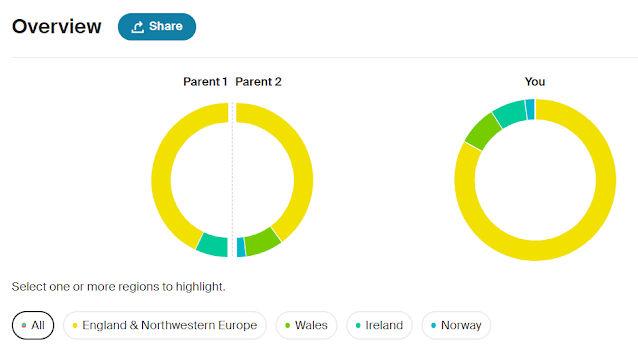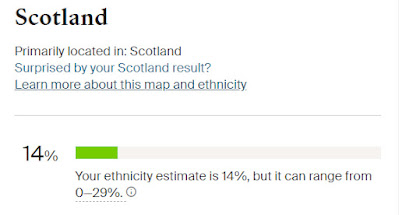There has been exciting news today with the announcement from MyHeritage that they will be transitioning to whole-genome sequencing (WGS) for the MyHeritage DNA test test. This is a direct-to-consumer DNA test which provides customers with DNA matches with relatives along with a biogeographical ancestry report. This landmark announcement heralds a new era of whole genome sequencing for genetic genealogy with the long-anticipated use of WGS for relative matching.
Relative-matching for genetic genealogy has been available since late 2009 but in order to keep the costs down the companies have always used microarray technology. A number of different microarrays have been made available over the years covering between 600,000 and about a million base pairs. The new MyHeritage test WGS will sequence almost the entire human genome comprising over three billion base pairs. WGS is now being applied to most new MyHeritage DNA kits currently being processed at the lab, and to every new MyHeritage DNA kit sold moving forward. Incredibly, the test is being offered at the same price as the existing MyHeritage test (including sale prices). Existing customers who have tested on the older microarray technology will not have their kits upgraded but the low cost is not likely to be a barrier for most genetic genealogists.
Update. I have now been told by MyHeritage that “You can buy the kit now, but only those arriving at the lab in Jan 2026 will be warranted to have WGS." If you order a kit I would therefore recommend delaying its return to ensure you get the WGS test.
The sequencing is being done in the Gene by Gene laboratories using technology powered by Ultima Genomics. Gene by Gene are the parent company of FamilyTreeDNA who specialise in Y-chromosome and mitochondrial DNA testing.
Technical details
I asked MyHeritage about the coverage of the new MyHeritage and was advised that they will be using low-coverage 2x sequencing. Coverage refers to the number of times a base is read by the sequencing machine. Clinical-grade sequencing, where the goal is to detect rare variants, is normally done at 30 x or higher. FamilyTreeDNA's BigY test has a read-depth of 70 x. However, for relative matching and biogeographical ancestry analysis the depth of the reads is less important than the quantity of data available, and a few missing or incorrect reads are not going to be a major problem.
The MyHeritage scientists validated their methods in a 2020 preprint by Petter et al "Relative matching using low coverage sequencing". In that study the sequencing was done at 1 x coverage. This meant that only one of the two bases at each position in the genome was sequenced. Nevertheless, the researchers were able to replicate the performance of microarrays for identifying relatives at the third cousin level or closer. The authors estimated that the cost of 1x sequencing was around $30 and commented at the time "We envision that in the short term 1x coverage can be a good sweet spot for consumer genomics, balancing quality and price." Clearly the costs of sequencing have come down in the interim to make 2x coverage the sweet spot for the roll out of WGS for genetic genealogy.
Compatibility
MyHeritage have made all the needed measures and adjustments to make sure that users' results (Ethnicity Estimate, Genetic Groups and DNA Matches) for those who will be sequenced with WGS will be compatible with all other DNA data files. They have made the required imputation and phasing changes required in order for this to happen. In other words, those who previously tested with array chips or have uploaded their data to MyHeritage from another service will still be matched to those who will be sequenced with WGS.Uploads
Implications
I will be ordering the new MyHeritage WGS test. I have already tested direct at MyHeritage with a microarray test and I have also transferred my AncestryDNA results to MyHeritage. I will therefore have the ability to do a three-way comparison to test the performance. I am also fortunate that both of my parents have tested and are in the MyHeritage database.
Currently with my Ancestry transfer kit I have 12,279 matches but 38% of those matches don't match either of my parents.
With my direct MyHeritage DNA test I have 11,049 matches but 47% of those matches don't match either of my parents.
The non-matching with my parents is caused either by false positive or false negative matches. Spurious matches become a particular problem with smaller segment matches. I anticipate that with the WGS test the number of false matches will be reduced and the detection of smaller segments will be improved. We don't yet have details of how the matching process will work at MyHeritage and how many markers will be used for the comparison process. I hope that a white paper will be forthcoming.
It is also anticipated that WGS will improve the biogeographical ancestry reports and I look forward to future developments.
I will update this blog post if further information become available.
Further reading
- MyHeritage upgrades its DNA test to whole-genome sequencing - blog post from MyHeritage, 17 October 2025.
Further details of the new MyHeritage test are provided in the press release reproduced below.
MyHeritage Upgrades Its Consumer DNA Tests
to Whole Genome Sequencing
MyHeritage becomes the first major DNA testing company to fully adopt Whole Genome Sequencing; the upgrade leverages technology by Ultima Genomics and processing at the Gene by Gene lab
TEL AVIV, Israel & LEHI, Utah & HOUSTON & FREMONT, California October 14 , 2025 — MyHeritage, the leading global platform for family history and DNA testing, announced today a landmark move to Whole Genome Sequencing for its at-home DNA test, MyHeritage DNA. Leveraging cutting-edge sequencing technology from Ultima Genomics and processing at the Gene by Gene lab, MyHeritage is the first major consumer DNA testing company to adopt Whole Genome Sequencing at a scale of more than one million tests per year. The enriched data will empower MyHeritage to deliver more accurate ethnicity analysis and DNA matching, and unlock opportunities for future innovation in consumer genomics and genetic genealogy.
Whole Genome Sequencing reads almost the entire human genetic code, covering around 3 billion base pairs (nucleotides). This is superior to the standard genotyping arrays used by most consumer DNA tests, including MyHeritage until recently, which read only about 700,000 base pairs. More data enables deeper insights across all types of genetic analysis. Whole Genome Sequencing is now being applied to most new MyHeritage DNA kits currently being processed at the lab, and to every new MyHeritage DNA kit sold moving forward. MyHeritage DNA kits already processed with the older genotyping array technology will not be reprocessed with Whole Genome Sequencing. Customers whose MyHeritage DNA kits are processed with Whole Genome Sequencing will be able to download their entire genome from MyHeritage at no cost, in CRAM format. They may also unlock additional insights by uploading their data to other trusted genetic service providers that support such uploads.
Due to its high technological potential, MyHeritage has been eying Whole Genome Sequencing for years. A pioneering study by the MyHeritage Science Team published in 2020 validated Whole Genome Sequencing for reliable relative matching at scale. Following that study, MyHeritage has been collaborating closely with Ultima Genomics since its emergence from stealth mode in mid-2022, and later jointly with Gene by Gene, to prepare the scientific and logistical foundation for upgrading the MyHeritage DNA processing pipeline to Whole Genome Sequencing using Ultima’s technology. The upgrade was completed successfully and creates new opportunities for MyHeritage to deliver deeper insights into ethnic origins, family connections, and genetic genealogy, without any price increase to consumers. Even before this upgrade, MyHeritage was consistently the most affordable DNA test on the market among the major DNA testing companies. The upgrade to Whole Genome Sequencing makes the MyHeritage offering even more compelling.
“This is a pivotal moment for genetic genealogy,” said Gilad Japhet, Founder and CEO of MyHeritage. “We are proud to take this pioneering step into Whole Genome Sequencing together with Ultima Genomics and with our longstanding partners at Gene by Gene. MyHeritage customers will enjoy the fruits of this technological upgrade for years to come, through increased accuracy, deeper insights, and exciting new products.”
“MyHeritage’s move to Whole Genome Sequencing marks a major milestone for consumer DNA testing,” said Dr. Gilad Almogy, Founder and CEO of Ultima Genomics. “It demonstrates the scalability and maturity of Ultima’s innovative technology and accelerates the immense value that Whole Genome Sequencing can bring to consumers. It has been a pleasure collaborating with MyHeritage over the past few years, and we are proud to work together with them and Gene by Gene to bring genetic genealogy to new heights for millions of consumers worldwide.”
“The transition to Whole Genome Sequencing represents the most ambitious project in our years-long partnership with MyHeritage,” said Dr. Lior Rauchberger, CEO of Gene by Gene. “We are proud to help set a new standard in consumer genomics and support the growth of what will soon become the world’s largest database of whole genomes. The rollout is centered at Gene by Gene’s state-of-the-art laboratory in Houston, Texas, which will house a large fleet of Ultima UG100™ sequencing instruments.”
Privacy Commitment
MyHeritage is committed to the privacy and security of its customers' data. All genetic data is encrypted and stored securely, and MyHeritage does not sell or license data to third parties. MyHeritage strictly prohibits the use of its platform by law enforcement. All genetic samples are automatically destroyed by the lab after processing, except those stored securely for customers who have enrolled in the MyHeritage DNA BioBank service. This provides customers with peace of mind not offered by most other major DNA testing companies.
About MyHeritage
MyHeritage is the leading global platform for family history. It enriches the lives of people worldwide by enabling them to uncover more about themselves and where they belong. With a suite of intuitive products, billions of historical records, AI-powered photo tools, and an affordable at-home DNA test, MyHeritage creates a meaningful discovery experience that is deeply rewarding. The MyHeritage platform is enjoyed by more than 62 million people around the world who treasure and celebrate their heritage. MyHeritage is committed to the privacy and security of its customer data and is available globally in 42 languages. www.myheritage.com
About Ultima Genomics
Ultima Genomics is unleashing the power of genomics at scale. The company's mission is to continuously drive the scale of genomic information to enable unprecedented advances in biology and improvements in human health. With humanity on the cusp of a biological revolution, there is a virtually endless need for more genomic information to address biology's complexity and dynamic change—and a further need to challenge conventional next-generation sequencing technologies. Ultima's revolutionary new sequencing architecture drives down the costs of sequencing to help overcome the tradeoffs that scientists and clinicians are forced to make between the breadth, depth and frequency with which they use genomic information. The new sequencing architecture was designed to scale far beyond conventional sequencing technologies, lower the cost of genomic information and catalyze the next phase of genomics in the 21st century. www.ultimagenomics.com
About Gene by Gene
Gene by Gene is a world leader in genetic testing services with over 20 years of experience. Its laboratory holds accreditation from multiple agencies, including CAP, CLIA, New York State Department of Health, California Department of Public Health, and AABB. With a cutting-edge laboratory and highly trained team of experts, Gene by Gene is committed to excellence in the field of genetic analysis. www.genebygene.com

















